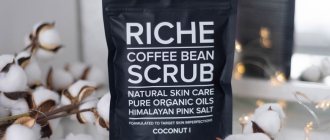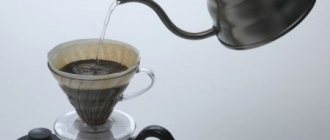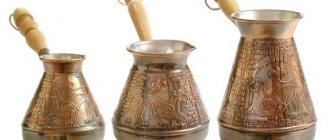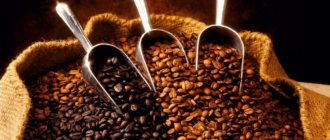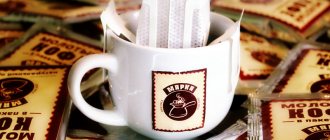You see a pack of coffee with the inscription “strawberry, raspberry, kiwi” and wonder: is this an online coffee store or a marmalade shop? With marmalade, everything is clear: flavorings can add any flavor to a mixture of gelatin and sugar. What about coffee? Is it scented too?
Flavored, yes. In stores you can find coffee with the aroma of chocolate, amaretto, vanilla... I was once given a pack of coffee from a well-known manufacturer, on which was written “blood orange” (and nothing else was written). Out of curiosity, I brewed it - it smelled like blood orange, yes, and very strongly. But the coffee tasted absolutely nothing. I wasn’t even surprised: it’s logical that no one will flavor fresh, high-quality, good coffee - why add artificial odors to a product in which more than 800 aromatic compounds have already been found (and continue to be searched)?
Story
The tradition of drinking coffee with aromatic additives came from the Middle East. To soften the bitterness, the Arabs added nuts and spices to the drink: cinnamon, pepper, vanilla and cloves. In the 17th century, the fashion for coffee with chocolate spread in Europe. The original combination of products from different parts of the world became popular in the salons of noble people. The first coffee syrups appeared at the beginning of the 20th century. With the development of technology, manufacturers have learned to introduce aromatic components already at the stage of roasting beans.
Flavored coffee began to rapidly gain popularity in the early 90s thanks to growing consumer interest in exotic flavors. Manufacturers have conflicting opinions about flavored varieties. Owners of small roasting shops refuse to add flavorings to beans, as they believe that this spoils the natural qualities of the product. Large companies produce a wide range of coffee with different tastes, focusing on customer requests.
Types of coffee flavors
Flavoring is the process of processing coffee to change or enhance its flavor and aroma properties. Natural extracts of various fruits and plants allow you to obtain a rich palette of tastes and aromas. The cost of such concentrates is quite high, so artificial additives are often used.
To achieve optimal results, manufacturers combine natural and synthesized ingredients.
Coffee flavors are either natural or synthetic (chemical)
Popular tastes can be divided into groups:
- fruits and nuts - orange, lemon, almonds, hazelnuts;
- sweets – chocolate, caramel;
- spices – vanilla, cinnamon, mint;
- alcoholic drinks – Baileys (Irish Cream), Irish whiskey, Amaretto.
Natural oils are extracted from various nuts, vanilla pods, and cocoa beans. Cloves, cinnamon and chicory are often used to add special flavors. Synthetic fragrances are the fruit of the labor of chemical laboratories. For example, the substance 2,5-dimethylpyrazine can give the product a peanut taste. Chemists use many combinations to achieve desired properties. A coffee flavor can contain up to 80 compounds.
Technology for the production of flavored coffee beans
Coffee contains about 350 aromatic substances. Their concentration depends on the method of processing the beans, as well as on the degree of roasting. Too intense heat treatment leads to the dominance of natural essential oils, so medium-roasted beans are chosen for flavoring. The beans are pre-cooled because high temperatures can destroy the flavor structure.
The average amount of aromatic substances added to grains is 2.7%. The indicator may change up or down depending on the specified intensity and the final cost of the product. New varieties are developed by trial and error. Test batches are seasoned with different amounts of extracts until the desired result is obtained.
The roasted beans are placed in a large drum that can gently turn the beans without disturbing their integrity. Flavorings are introduced using spray units. Essential oils are added gradually, stirring the grains regularly to avoid areas of high aroma concentration. Processing one batch takes from 15 to 30 minutes.
What and how affects taste
Type of coffee and place of growth
If we compare two popular types of coffee, Arabica is chemically more complex than Robusta. It has more acids and, accordingly, more facets of taste. Robusta will more often be woody, earthy, bitter. I had the opportunity to try fine robusta - this is a high quality grain that was grown and processed with the same attention as expensive Arabica. Yes, it had more sweetness, but due to minimal acidity its taste remained inexpressive.
It is difficult to talk about the connection between the taste of coffee and each specific variety, but terroir definitely has a huge influence on the taste - this is the set of natural conditions in which coffee grows. Climate, growing height, soil, humidity and number of sunny days - all this shapes the chemical composition of the grain, including the flavor and aroma. For example, high altitude coffee will have richer acidity because it matures more slowly. Coffee grown in the same natural conditions - in the same country, in the same region, on the same farm - will have certain taste characteristics that will distinguish it from coffee of the same variety grown on other plantations. I won’t talk in detail about the connection between terroir and taste—you can read about this, for example, in Ilya Savinov’s article for Eda.ru magazine.
Treatment
The taste of coffee also depends on how it was processed. Washed coffee typically has bright, complex acidity. Naturally processed beans have a lot of sweetness and fruity notes. Processing honey gives the grain the sweetness of honey and cane sugar.
Experimental treatments and various types of fermentation are now popular. I won’t write about how fermentation affects taste this time (but very soon), but for now I’ll just say that some types of experimental fermentation can add bright shades of alcoholic liqueurs, dried fruits and even whey to coffee.
Roasting
The most interesting thing, of course, happens during roasting: high temperatures trigger many chemical reactions. Thanks to roasting the grain, the “enzyme” component of the taste is revealed - what was laid down by the terroir and processing: fruit, berry, floral shades. It is complemented by flavor shades belonging to the “caramelization of sugars” group - this is not only caramel, but also chocolate and roasted nuts.
At a temperature of about +150°C, the Maillard reaction starts - the interaction between proteins and carbohydrates in the grain. This is the same process that occurs when baking bread or frying meat. The grain takes on a brown tint, and the aroma smells like baking. It is thanks to this reaction that we smell the bright smell of roasted grain.
Strecker degradation occurs in parallel with the Maillard reaction. This process produces aldehydes and ketones, volatile compounds responsible for fruity and herbal aromas.
At a temperature of about +170°C, caramelization begins - complex carbohydrates begin to break down into sugar molecules. At this time, the sweetness of the grain increases, and caramel and nuts appear in the aroma.
The degree of roasting of the grain also affects the taste: the lighter the grain is roasted, the more acids and enzymatic aromas remain in it; the darker it is, the less acidity, but more sweetness and aromas from the caramelization group. The main thing is not to miss the moment and not to burn the coffee: if the sugars in it start to burn, the coffee will become empty, bitter and charcoal in taste.
Aromatization of ground and instant coffee
Flavorings are added to ground grains in dry form, enclosing the concentrate in capsules. The moisture contained in coffee helps the flavor and aroma spread over a 24-hour period. To avoid loss of the obtained properties, the product is packaged as quickly as possible. To limit the contact of coffee with oxygen, the containers are purged with nitrogen. This technique allows you to preserve aromas for up to two to three years.
Instant coffee is flavored in different ways. Additives are mixed with coffee extract or added to the finished product after spray or freeze drying.
Among the innovative methods are special filters for coffee machines that contain flavorings. In this case, the consumer himself chooses what kind of coffee to drink - regular or with a certain taste.
Freshness
The main misconception is that coffee can be stored for a long time, almost forever. This is a big mistake and, one might say, a key one! Coffee can perhaps be compared to chocolate candies in paper candy wrappers, which after production will be delicious for three months, and if after purchase they sit for 6 months, a year or even two, then there is great doubt whether you will offer them to your children and whether you will eat them yourself. Yes, it is possible that sweets, just like coffee, will remain safe for health, but there is no doubt that they will no longer be as fresh. The thing is that when coffee is roasted, the fermentation process starts, chemical processes begin in which coffee gradually changes and loses its taste and aroma over time. Large manufacturers pump nitrogen into the packaging, which slows down the oxidation process and preserves the coffee, but in our opinion this does not save for long. The manufacturer often writes that the shelf life is 1 or 2 years. But no matter how wonderful and elite the coffee is, after 6 months, and even more so a year or two after roasting, it most likely will not be unsuitable for preparation, but in our opinion this is just like making coffee from sawdust and fir cones.
When buying coffee, the first thing you need to look at is the production date! Secondly, the variety or mixture is important. For example: if you compare an elite type of coffee that has been lying in warehouses and store shelves for more than 6 months and a freshly roasted one that is only a couple of weeks old, then the first one, at best, will taste like a not-so-best instant coffee, but you will definitely enjoy freshly roasted coffee!
The question arises: why is this so? In reality, coffee is a berry, a carefully grown, processed agricultural product. So the fresher the better.
Now we know how to choose coffee from hundreds of offers! We buy beans that have the roasting date clearly printed on them. A manufacturer that can't tell us this information probably just doesn't want to.
After opening the package of coffee, it should be used within a week, or two at most. During this period, the coffee will be as aromatic and tasty as possible. To prevent it from running out of steam, carefully close the bag using clamps or other means, the main thing is to reduce the contact of the grains with air.
Coffee can be used for up to 4 weeks after opening the package, but after 14 days the quality and intensity of the aroma will begin to fade.
Safety of Flavored Coffee
Well-known companies carefully control the quality of their products at all stages of production, using additives that are tested and approved for food production. Natural and synthetic components are analyzed both separately and in mixed form. The taste of the finished batch is checked in automatic installations: spectrographs and gas chromatographs. There are a number of regulations that companies must adhere to in assessing the safety of products.
Since fragrances contain many components, any of them can cause a reaction in people prone to allergies. When purchasing, pay attention to the composition of the product and choose manufacturers who use natural additives.
In addition, a flavored drink tastes more pleasant, so there is a danger of getting carried away and not calculating a safe dose of caffeine. Otherwise, flavored coffee is no more harmful than regular coffee.
Coffee-Car
Home → Questions and answers
For your convenience, we will try to include here the most frequently asked questions, we hope this will be useful, save your time and help you make the right choice.
1.Which coffee machine is the best, doesn’t break down, isn’t expensive, and makes delicious coffee?
Answer: An ideal coffee machine, like other equipment, does not exist; something will always have to be sacrificed. The price does not always reflect the quality of the coffee machine; more often it is a payment for appearance, and displays with a large number of buttons. An example of an inexpensive but high-quality coffee machine can be called the Delonghi Magnifica, which also brews delicious and strong espresso.
2. Is it possible to make drinks from pre-ground coffee in an automatic coffee machine?
Answer: Of course. But you need to do this according to the instructions, avoid spilling excess coffee, use the measuring spoon that comes with the coffee machine. The dose of coffee is approximately 6-10 grams. Too much coffee can cause the device to malfunction. It is safer to use whole grain coffee.
3. What kind of coffee can be used in the coffee machine, types and varieties?
Answer: Coffee suitable for use in a coffee machine must be well-roasted and dry, wet and raw coffee is not allowed, coffee should not be very greasy, if there is a greasy sheen on the beans, it cannot be used in a coffee machine. Wet or greasy coffee will clog the coffee grinder and the coffee machine will have to be repaired. Coffee for a coffee machine should be dry and matte without shine. At the same time, the varieties and varieties of coffee may be different.
4. Can I use flavored coffee?
Answer: It is highly undesirable, flavored coffee becomes sticky and is not always completely dry, it can clog the coffee grinder, brewing unit and even corrode the plastic of the coffee container.
5. How does a coffee machine determine that it’s time to clean, are there sensors built inside?
Answer: There are no sensors to detect contamination of the internal systems of the coffee machine; the cleaning time is determined by a counter that controls how many cups of coffee the coffee maker has brewed.
6. The coffee machine on the display indicates the need to clean, does this need to be done urgently, or can it be postponed?
Answer: It depends on the model of the coffee machine and how it was used, some coffee machines can wait for years to be cleaned, and some block the operation and will not brew coffee until the cleaning is done. In some coffee machines, cleaning is absolutely necessary, otherwise the brewing unit jams and the hydraulic system becomes clogged.
It is better to carry out cleaning regularly, as soon as a signal appears on the indicator, clean mechanisms still work longer.
7. Where can I buy a filter and cleaning products for household coffee machines and coffee makers?
Answer: Especially for your convenience, we have started selling cleaning products and filters for coffee machines. You can see the availability and cost in the section - Coffee machine care products, filters. If you travel far from us, then in this case you can go to a large large store selling household appliances and in the section where coffee machines are presented, as a rule, there are care products and filters.
8. What cleaning products are available for coffee machines?
Answer: For external cleaning, use a product that does not remove the paint along with the dirt. Do not use Acetone or solvent under any circumstances; you will damage the plastic and erase the inscriptions.
To clean the hydraulic system, there are products for removing coffee deposits and for decalcification. The descaling agent is added to the water hopper and the coffee deposit remover is added to the ground coffee compartment or special compartment. Do not try to add cleaning products to the coffee grinder!
9. How often should I remove and wash the brewing unit, and is it necessary to do this at all?
Answer: If the coffee machine has a removable brewing unit, then it is advisable to clean it regularly, on average after 50 cups of coffee. This could be once a week, or a month. Simply rinse the brewing unit under running warm water; you can use a small brush. After rinsing, it is not necessary to dry the brewing unit, because it already works with water, and there is no need to lubricate anything, this will only speed up the coffee sticking to the brewing unit; they work great without lubrication for years.
10. How much does it cost to repair my coffee machine?
Answer: Usually we are asked this question over the phone, often without naming the brand and model of the coffee machine and how the malfunction manifests itself, this is almost the same as asking a doctor what pills I should take, but without saying what hurts you. If this is cleaning, setup or departure, then the exact prices can be found in the section - Services and prices.
And if the coffee machine leaks, does not respond to buttons, some kind of error is displayed, the indicator is on, does not turn on, or something similar, then a meeting between the coffee machine and the master cannot be avoided. Only after diagnostics it will become clear what is not working, what caused the coffee machine to break down, what needs to be done and how much it will cost. In any case, after diagnostics, the cost of repairs is agreed upon by the repairman with the customer before performing the work.
11. Is it better to invite a repairman to your place for repairs, or to bring the coffee machine to the workshop?
Answer: Of course, it is better to carry out all repair work in the Service Center, there are many reasons for this: a place equipped for repairs, there is the necessary lighting, the necessary tools and parts are always at hand, more time and opportunity to inspect all the mechanisms - to identify worn ones. That is, to give the most complete conclusion on the condition of the car and carry out all the necessary work more conveniently in the workshop.
But if you don’t have the time, opportunity, or simply desire to take your car to the Service Center, then you can order a specialist visit from us. To do this, you need to name the brand of the coffee machine, the model and how the malfunction manifests itself, so that the technician can collect all the tools and parts necessary for repair. After the inspection, the master will give a conclusion and, if it is possible to do it on the spot, he will carry out the repair immediately, but the coffee machine may have to be taken to the workshop, which can also be done using CoffeeCar transport, and after the repair, the coffee machine will also be brought back.
12. What guarantee does CoffeeCar provide after repairs?
Answer: CoffeeCar company provides a guarantee on all installed parts and work performed; the guarantee applies only to those components and mechanisms that were subject to repair or replacement. The guarantee for the entire coffee machine is given only in case of major repairs, with the exception of the electronics unit, unless, of course, it has also been repaired. The warranty period depends on the model of the coffee machine, its condition and the work performed, and can range from 1 to 12 months. By default, unless agreed upon in advance, the warranty is 6 months, from the date the coffee machine is put into use.
If you have questions related to repairing, setting up, or choosing a coffee machine, and you did not find answers in what you read above, then write and ask, our specialists will definitely answer you! e-mail: [email protected]



